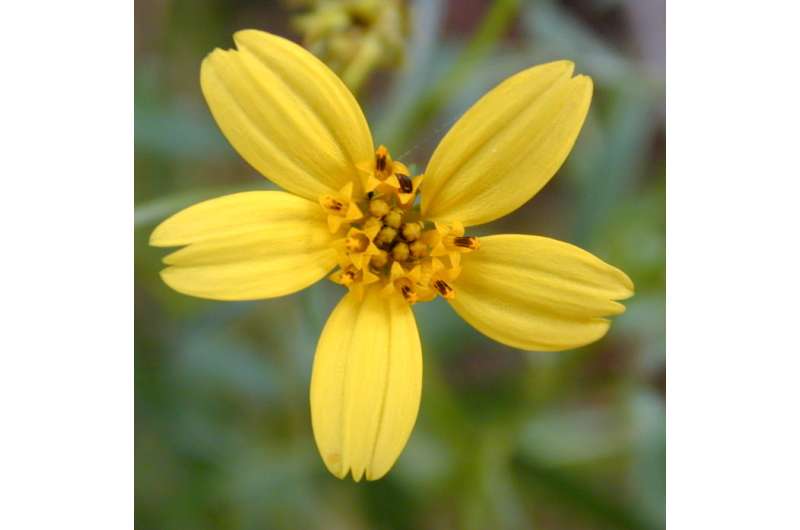A typical Asteraceae flower head (here Bidens torta) showing the individual flowers. Credit: Marshman/Wikipedia
(Phys.org)—A team of researchers with affiliations to research facilities in Argentina, the U.K. and New Zealand, has confirmed that fossilized pollen grains found in Antarctica are members of the flowering plant family Asteraceae. In their paper published in Proceedings of the National Academy of Sciences, the group describes their research and conclude by suggesting that the fossils represent the family's oldest fossils ever discovered.
The Asteraceae family includes a lot of popular modern flowers—daisy's, chrysanthemums, sunflowers, as well as gerberas, lettuce, artichokes and even dandelions. One of their main characteristics is inflorescence, which means they have clusters of flower heads that form the larger flower. It is believed that they played a major role in the evolutionary history of many insects and pollinating birds and also perhaps that of bees and wasps. Prior research had placed their earliest known evolutionary history to approximately 60 million years ago. This new research has revealed evidence that pushes that history back another 20 million years—to the Cretaceous, which means the flowers were growing back when dinosaurs were still around.
The pollen grains were found on the eastern side of the Antarctic Peninsula, a part of what was once the super-continent Gondwana—back then the area would have been covered by lush grasslands and temperate forests. In studying the fossils, the team noted their shape, size and surface sculpture, placing them in the species Tubulifloridites lillei—other samples had been found in Australia and New Zealand but it was not until the new fossils were found in Antarctica that researchers could definitively prove that they were also members of the Asteraceae family. Further study showed that the more recently found pollen grain fossils were similar in ways to members of the Barnadesioideae subfamily of Asteraceae found today in South America, which offers a hint of what the earlier flowers might have looked like.
There is still more work to be done before the new fossil finds can be officially placed in the flowering plants family tree, but once that happens, the researchers are confident that they will be placed at a time approximately 80 million years ago.
More information: Early evolution of the angiosperm clade Asteraceae in the Cretaceous of Antarctica, Viviana D. Barreda, Proceedings of the National Academy of Sciences, DOI: 10.1073/pnas.1423653112
Abstract
The Asteraceae (sunflowers and daisies) are the most diverse family of flowering plants. Despite their prominent role in extant terrestrial ecosystems, the early evolutionary history of this family remains poorly understood. Here we report the discovery of a number of fossil pollen grains preserved in dinosaur-bearing deposits from the Late Cretaceous of Antarctica that drastically pushes back the timing of assumed origin of the family. Reliably dated to ∼76–66 Mya, these specimens are about 20 million years older than previously known records for the Asteraceae. Using a phylogenetic approach, we interpreted these fossil specimens as members of an extinct early diverging clade of the family, associated with subfamily Barnadesioideae. Based on a molecular phylogenetic tree calibrated using fossils, including the ones reported here, we estimated that the most recent common ancestor of the family lived at least 80 Mya in Gondwana, well before the thermal and biogeographical isolation of Antarctica. Most of the early diverging lineages of the family originated in a narrow time interval after the K/P boundary, 60–50 Mya, coinciding with a pronounced climatic warming during the Late Paleocene and Early Eocene, and the scene of a dramatic rise in flowering plant diversity. Our age estimates reduce earlier discrepancies between the age of the fossil record and previous molecular estimates for the origin of the family, bearing important implications in the evolution of flowering plants in general.
Journal information: Proceedings of the National Academy of Sciences
© 2015 Phys.org























